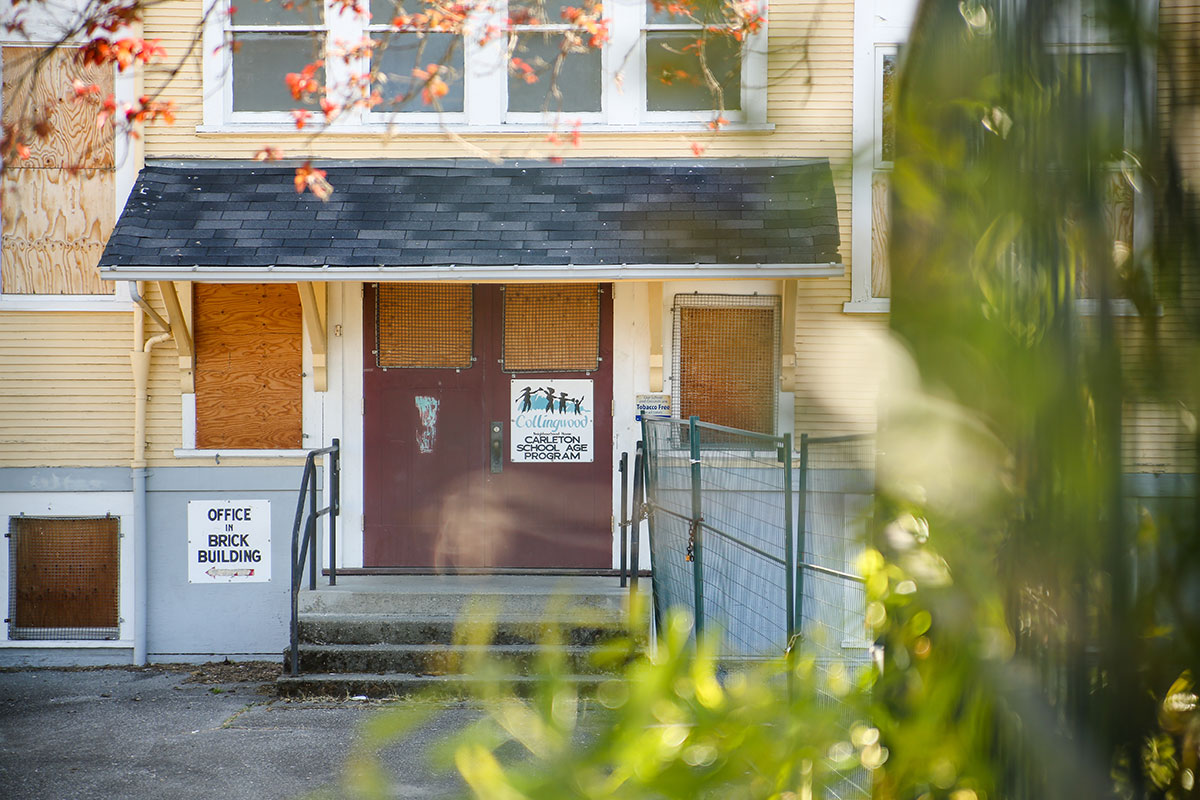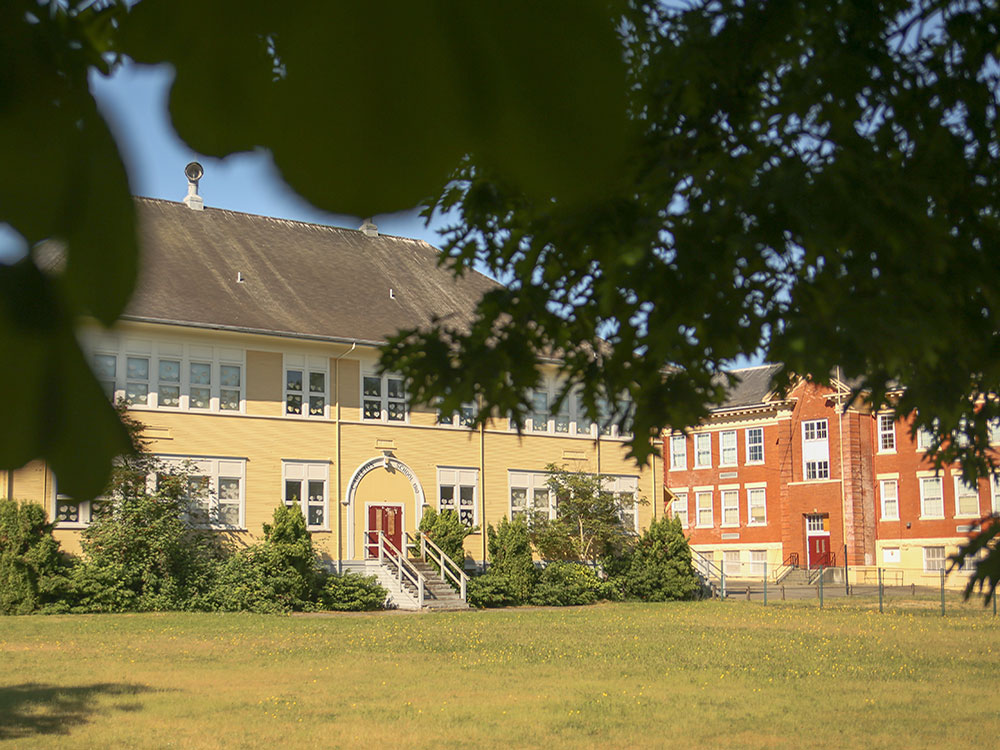It’s been seven years since a fire caused Sir Guy Carleton elementary to shut its doors.
Although Carleton’s students were split between three other elementary schools within two kilometres of the southeast Vancouver school, 62 kids are still technically enrolled at Carleton, which is operating within G.T. Cunningham elementary.
But that may end this fall when the school board considers permanently closing the 111-year-old Sir Guy Carleton elementary school.
During a Vancouver School Board meeting on May 29, staff recommended the board start the process to decide whether to close the school for good, as the last of Carleton’s students graduate from the kindergarten to Grade 7 school at the end of June.
The main Sir Guy Carleton elementary building has the highest seismic risk rating, yet it is one of 45 Vancouver schools requiring seismic upgrades that have no upgrade plans. The Ministry of Education has refused to cover the estimated $8 to $10 million cost of repairing the damages caused by the fire and subsequent vandalism, staff told the board.
Deputy Supt. David Nelson said that because of the school’s low enrolment — 10 per cent of the building’s 557 student capacity — there is no business case for seismic upgrading.
The majority of Vancouver School Board trustees at the May 29 meeting voted in favour of considering the closure. Only trustees Jennifer Reddy and Suzie Mah voted against, with Reddy pointing out the area’s uniquely high density zoning, high population of kids living in apartment buildings and low child-care coverage.
“I anticipate that there would be future educational needs for this site,” Reddy said during the meeting.
The VSB’s Facilities Planning committee will consider the closure and send recommendations back to the board at their June 7 meeting. At the same meeting the committee is also set to discuss whether the board should declare 0.39 hectares of the 1.98 hectares of land Graham D. Bruce elementary sits on surplus so the district can sell or lease it.
The move to close Carleton raises questions about discrepancies between predictions about enrolment and population growth made by the Education Ministry and those made by the VSB — discrepancies that are likely to recur as the board makes future decisions about seismic upgrades, school closures and selling or leasing land.
During their June 26 meeting the board will decide whether to decline to move forward with the Carleton closure process or proceed with public consultations over a period of at least 60 days. If the board moves ahead with the closure consultation process, the final board vote on whether to close Sir Guy Carleton elementary could happen in November. If approved, closure would take effect Jan. 1, 2024.
Enrolment projection discrepancies
City data shows the population of kids in Renfrew Collingwood is declining. That’s also what the Vancouver School Board’s population projection shows for the entire district, with a decrease of 3,000 students expected by 2031.
However the district’s data directly contradicts the Education Ministry’s projection, which estimated the district will see 10,000 additional students by 2031.
Unlike the Education Ministry, which uses census information to predict future district enrolment, the VSB works with Baragar Systems Ltd., which uses “proprietary information that the district pays to access,” VSB spokesperson Jiana Chow told The Tyee via email, to create their enrolment projection.
“Census data has been shown to be insufficiently sensitive to reliably and accurately forecast enrolment,” Chow wrote.
Instead, the district relies on vital statistics information, child tax benefit recipient data, catchment enrolments and kindergarten registrations to create its projections. Chow pointed to Chapter 4 of the district’s 2020 Long Range Facilities Plan for further information on how the district validates their enrolment projections.
But critics, including the District Parents Advisory Council, have pointed to the district’s disregard of planned housing projects in their projections as evidence their numbers are flawed.
“Sometimes the experience I get from parents is quite different from the data that’s being presented,” Reddy said.
‘It doesn’t mean we don’t need it’
Since 2016, the majority of Carleton students relocated to G.T. Cunningham elementary, which has an equally high seismic risk and no current plan for seismic upgrading.
Despite an operating capacity of 557 students, there were only 308 students enrolled at Carleton for September 2016 before the fire that summer. Of those, 116 actually enrolled in “Carleton at Cunningham” that fall, according to the staff background report included in the May 29 meeting agenda.

As of September 2021, Cunningham elementary housed 59 Carleton students, while Dr. George M. Weir elementary, which has since been seismically upgraded, had 44 Carleton students, and Dr. H.N. MacCorkindale elementary, which has a less high but still serious seismic risk rating and no plans for upgrading, had 28 Carleton students.
Earlier this year the VSB voted to change the catchments for all four elementary schools, removing all residential areas within the Carleton catchment and dividing them up between the other three school catchments. District staff said Weir, Cunningham and McCorkindale all had surplus capacity.
Last week staff suggested using the 2.5-hectare Carleton site to create revenue for the district through long-term lease or sale of portions of the land. They added the district is working with the Education Ministry, the city, BC Housing and the francophone school board to “develop options” for use of the land.
But there has been discrepancy in the recent past between school communities, the district and the province over whether schools have surplus space, and can house more students.
Because of this Reddy told The Tyee she wants to hear from families with kids in the area before making any decisions.
“My concern is that we’re closing it because it hasn’t been open since the fire, but it doesn’t mean we don’t need it,” Reddy told The Tyee, adding the neighbourhood is only meeting 20 per cent of child-care needs for kids five and under, which could be addressed by establishing child-care spaces on the Carleton site.
Reddy also pointed to Carleton and Cunningham’s location at the south edge of Renfrew Collingwood, a neighbourhood that is 17 per cent more dense, with larger families with more kids, than the city average. The majority of Vancouver’s schools are over 75 years old, she added, and over 40 have no plans for needed seismic upgrades like Carleton.
“What I’d like to see, and I’ve advocated for this before, is a multi-year strategy that goes beyond 10 years but actually looks at how we will use our asset base, which is very generous — we have $ 8 billion in land holdings — to generate lease revenue,” she said, citing the district-owned land where Kingsgate Mall is located as an example.
“Rather than looking at individual sites or individual school projects, I would like us to have a very long-term vision that enables us to have revenue streams coming in so we don’t have to put pressure on individual communities to advocate for their school,” she said, adding the VSB should consider city data on future housing developments when making plans for schools.
Closures predicted earlier this spring
This past April rumours spread that the VSB was planning to close schools in order to balance the 2023-24 school year budget. Board chair Victoria Jung denied this and a balanced budget, achieved without school closures, was passed May 10.
But trustee Suzie Mah warned the school board could announce the closure process at any time, because of expected future operating budget deficits. “I know that some [trustees] do believe in closing schools as a way to balance the budget,” she told The Tyee in April.
Sir Guy Carleton was on a potential school closure list back in 2016 and in 2019, but was spared. All but two of the schools on the school closure lists are located on the city’s east side.
Another school, Queen Elizabeth Annex, was also on both closure lists. The VSB voted to close that school in 2022 for several reasons: the low enrolment of the French immersion school, the long list of bigger schools still waiting for seismic upgrades, a $14.5 million district budget deficit, and pressure from the provincial government and Conseil scolaire francophone de la Colombie-Britannique to lease or sell the land to the francophone school district.
Parents of QEA students filed a judicial review petition in B.C. Supreme Court to prevent the closure of the Annex at the end of this month. Hearings were held last week.
Not long before the school board rejected closing the annex in 2019, then-education minister Rob Fleming tied approval for a long-awaited new elementary school in the Olympic Village neighbourhood to the district giving QEA to the Conseil scolaire francophone de la Colombie-Britannique.
Later the NDP pledged to fund the Olympic Village school, which the school district has been asking for since 2006, in their 2020 election campaign. Two and a half years later the VSB is still waiting on provincial funding for the new school.
Meanwhile, in central and downtown Vancouver, kindergarten lotteries take place for kids to attend a neighbourhood school. For this 2022-23 school year CBC reported 13 of the district’s 89 elementary schools had a kindergarten waitlist, forcing parents to enrol their children at schools further from home or hope a spot in their neighbourhood school became available by September. ![]()
Read more: Education, Municipal Politics, Urban Planning
















Tyee Commenting Guidelines
Comments that violate guidelines risk being deleted, and violations may result in a temporary or permanent user ban. Maintain the spirit of good conversation to stay in the discussion and be patient with moderators. Comments are reviewed regularly but not in real time.
Do:
Do not: